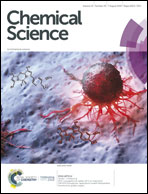Phosphorus corrole complexes: from property tuning to applications in photocatalysis and triplet–triplet annihilation upconversion†
Abstract
Efficient triplet photosensitizers are important for fundamental photochemical studies and applications such as triplet–triplet annihilation upconversion (TTA UC), photoredox catalytic organic reactions and photovoltaics. We now report a series of phosphorus corrole compounds as efficient visible light-harvesting metal-free triplet photosensitizers. While the heavy-atom-free phosphorus corroles show absorption in the visible spectral region (centered at 573 nm) and have a decent triplet state quantum yield (ΦΔ = 49%), iodo-substitution on the corrole core induces red-shifted absorption (589 nm) and improves intersystem crossing significantly (ΦΔ = 67%). Nanosecond transient absorption spectra confirm triplet state formation upon photoexcitation (τT = 312 μs) and the iodinated derivatives also display near IR phosphorescence in fluid solution at room temperature (λem = 796 nm, τp = 412 μs). Both singlet oxygen (1O2) and superoxide radical anions (O2−˙) may be produced with the phosphorus corroles, which are competent photocatalysts for the oxidative coupling of benzylamine (the Aza Henry reaction). Very efficient TTA UC was observed with the phosphorus corroles as triplet photosensitizers and perylene as the triplet acceptor, with upconversion quantum yields of up to ΦUC = 38.9% (a factor of 2 was used in the equation) and a very large anti-Stokes effect of 0.5 eV.



 Please wait while we load your content...
Please wait while we load your content...